COMPUTER
ARITHMETIC
Algorithms and Hardware Designs
S E C O N D E D I T I O N
Behrooz Parhami
Department of Electrical and Computer Engineering
University of California, Santa Barbara
NEW YORK OXFORD
OXFORD UNIVERSITY PRESS
2010
�
Oxford University Press, Inc., publishes works that further Oxford Universitiy’s
objective of excellence in research, scholarship, and education.
Oxford New York
Auckland Cape Town Dar es Salaam Hong Kong Karachi
Kuala Lumpur Madrid Melbourne Mexico City Nairobi
New Delhi Shanghai Taipei Toronto
with offices in
Argentina Austria Brazil Chile Czech Republic France Greece
Guatemala Hungary
Italy Japan Poland Portugal Singapore
South Korea Switzerland Thailand Turkey Ukraine Vietnam
Copyright © 2010 by Oxford University Press, Inc.
Published by Oxford University Press, Inc.
198 Madison Avenue, New York, New York 10016
http://www.oup.com
Oxford is a registered trademark of Oxford University Press
All rights reserved. No part of this publication may be reproduced,
stored in a retrieval system, or transmitted, in any form or by any means,
electronic, mechanical, photocopying, recording, or otherwise,
without the prior permission of Oxford University Press.
Library of Congress Cataloging-in-Publication Data
Parhami, Behrooz.
Computer arithmetic / Behrooz Parhami. – 2nd ed.
p. cm.
ISBN 978-0-19-532848-6
1. Computer arithmetic. 2. Computer algorithms. I. Title.
QA76.9.C62P37 2009
005.1—dc22
2009034155
Printing number: 9 8 7 6 5 4 3 2 1
Printed in the United States of America
on acid-free paper
�
To the memory of my father,
Salem Parhami (1922–1992),
and to all others on whom I can count
for added inspiration,
multiplied joy,
and divided anguish.
�
PREFACE to the first edition
THE CONTEXT OF COMPUTER ARITHMETIC
Advances in computer architecture over the past two decades have allowed the per-
formance of digital computer hardware to continue its exponential growth, despite
increasing technological difficulty in speed improvement at the circuit level. This phe-
nomenal rate of growth, which is expected to continue in the near future, would
not have been possible without theoretical insights, experimental research, and tool-
building efforts that have helped transform computer architecture from an art into one
of the most quantitative branches of computer science and engineering. Better under-
standing of the various forms of concurrency and the development of a reasonably
efficient and user-friendly programming model have been key enablers of this success
story.
The downside of exponentially rising processor performance is an unprecedented
increase in hardware and software complexity. The trend toward greater complexity is
not only at odds with testability and certifiability but also hampers adaptability, perfor-
mance tuning, and evaluation of the various trade-offs, all of which contribute to soaring
development costs. A key challenge facing current and future computer designers is to
reverse this trend by removing layer after layer of complexity, opting instead for clean,
robust, and easily certifiable designs, while continuing to try to devise novel methods for
gaining performance and ease-of-use benefits from simpler circuits that can be readily
adapted to application requirements.
In the computer designers’ quest for user-friendliness, compactness, simplicity, high
performance, low cost, and low power, computer arithmetic plays a key role. It is one
of oldest subfields of computer architecture. The bulk of hardware in early digital com-
puters resided in accumulator and other arithmetic/logic circuits. Thus, first-generation
computer designers were motivated to simplify and share hardware to the extent pos-
sible and to carry out detailed cost–performance analyses before proposing a design.
Many of the ingenious design methods that we use today have their roots in the bulky,
power-hungry machines of 30–50 years ago.
In fact computer arithmetic has been so successful that it has, at times, become
transparent. Arithmetic circuits are no longer dominant in terms of complexity; registers,
memory and memory management, instruction issue logic, and pipeline control have
xix
�
xx
Preface
become the dominant consumers of chip area in today’s processors. Correctness and
high performance of arithmetic circuits are routinely expected, and episodes such as the
Intel Pentium division bug of the mid 1990s are indeed rare.
The preceding context is changing for several reasons. First, at very high clock rates,
the interfaces between arithmetic circuits and the rest of the processor become critical.
Arithmetic units can no longer be designed and verified in isolation. Rather, an integrated
design optimization is required, which makes the development even more complex and
costly. Second, optimizing arithmetic circuits to meet design goals by taking advantage of
the strengths of new technologies, and making them tolerant to the weaknesses, requires
a reexamination of existing design paradigms. Finally, incorporation of higher-level
arithmetic primitives into hardware makes the design, optimization, and verification
efforts highly complex and interrelated.
This is why computer arithmetic is alive and well today. Designers and researchers
in this area produce novel structures with amazing regularity. Carry-lookahead adders
comprise a case in point. We used to think, in the not so distant past, that we knew all
there was to know about carry-lookahead fast adders. Yet, new designs, improvements,
and optimizations are still appearing. The IEEE 754 standard floating-point format has
removed many of the concerns with compatibility and error control in floating-point
computations, thus resulting in new designs and products with mass-market appeal.
Given the arithmetic-intensive nature of many novel application areas (such as encryp-
tion, error checking, and multimedia), computer arithmetic will continue to thrive for
years to come.
THE GOALS AND STRUCTURE OF THIS BOOK
The field of computer arithmetic has matured to the point that a dozen or so texts and
reference books have been published. Some of these books that cover computer arith-
metic in general (as opposed to special aspects or advanced/unconventional methods)
are listed at the end of the preface. Each of these books has its unique strengths and has
contributed to the formation and fruition of the field. The current text, Computer Arith-
metic: Algorithms and Hardware Designs, is an outgrowth of lecture notes the author
developed and refined over many years. Here are the most important features of this text
in comparison to the listed books:
Division of material into lecture-size chapters. In my approach to teaching, a lecture
is a more or less self-contained module with links to past lectures and pointers to what
will transpire in future. Each lecture must have a theme or title and must proceed
from motivation, to details, to conclusion. In designing the text, I strived to divide
the material into chapters, each of which is suitable for one lecture (1–2 hours). A
short lecture can cover the first few subsections, while a longer lecture can deal with
variations, peripheral ideas, or more advanced material near the end of the chapter.
To make the structure hierarchical, as opposed to flat or linear, lectures are grouped
into seven parts, each composed of four lectures and covering one aspect of the field
(Fig. P.1).
�
Preface
xxi
Emphasis on both the underlying theory and actual hardware designs. The ability to
cope with complexity requires both a deep knowledge of the theoretical underpin-
nings of computer arithmetic and examples of designs that help us understand the
theory. Such designs also provide building blocks for synthesis as well as reference
points for cost-performance comparisons. This viewpoint is reflected in, for example,
the detailed coverage of redundant number representations and associated arithmetic
algorithms (Chapter 3) that later lead to a better understanding of various multiplier
designs and on-line arithmetic. Another example can be found in Chapter 22, where
coordinate rotation digital computer, or CORDIC, algorithms are introduced from
the more intuitive geometric viewpoint.
Linking computer arithmetic to other subfields of computing. Computer arithmetic
is nourished by, and in turn nourishes, other subfields of computer architecture and
technology. Examples of such links abound. The design of carry-lookahead adders
became much more systematic once it was realized that the carry computation is
a special case of parallel prefix computation that had been extensively studied by
researchers in parallel computing. Arithmetic for and by neural networks is an area
that is still being explored. The residue number system has provided an invaluable
tool for researchers interested in complexity theory and the limits of fast arithmetic,
as well as to the designers of fault-tolerant digital systems.
Wide coverage of important topics. The text covers virtually all important algorith-
mic and hardware design topics in computer arithmetic, thus providing a balanced
and complete view of the field. Coverage of unconventional number representa-
tion methods (Chapters 3 and 4), arithmetic by table lookup (Chapter 24), which is
becoming increasingly important, multiplication and division by constants (Chapters
9 and 13), errors and certifiable arithmetic (Chapters 19 and 20), and the topics in
Part VII (Chapters 25–28) do not all appear in other textbooks.
Unified and consistent notation and terminology throughout the text. Every effort is
made to use consistent notation and terminology throughout the text. For example, r
always stands for the number representation radix and s for the remainder in division
or square-rooting. While other authors have done this in the basic parts of their texts,
many tend to cover more advanced research topics by simply borrowing the notation
and terminology from the reference source. Such an approach has the advantage
of making the transition between reading the text and the original reference source
easier, but it is utterly confusing to the majority of the students, who rely on the
text and do not consult the original references except, perhaps, to write a research
paper.
SUMMARY OF TOPICS
The seven parts of this book, each composed of four chapters, were written with the
following goals.
Part I sets the stage, gives a taste of what is to come, and provides a detailed per-
spective on the various ways of representing fixed-point numbers. Included are detailed
discussions of signed numbers, redundant representations, and residue number systems.
�
xxii
Preface
Part II covers addition and subtraction, which form the most basic arithmetic building
blocks and are often used in implementing other arithmetic operations. Included in the
discussions are addition of a constant (counting), various methods for designing fast
adders, and multioperand addition.
Part III deals exclusively with multiplication, beginning with the basic shift/add
algorithms and moving on to high-radix, tree, array, bit-serial, modular, and a variety of
other multipliers. The special case of squaring is also discussed.
Part IV covers division algorithms and their hardware implementations, beginning
with the basic shift/subtract algorithms and moving on to high-radix, prescaled, modular,
array, and convergence dividers.
Part V deals with real number arithmetic, including various methods for representing
real numbers, floating-point arithmetic, errors in representation and computation, and
methods for high-precision and certifiable arithmetic.
Part VI covers function evaluation, beginning with the important special case of
square-rooting and moving on to coordinate rotation digital computer, or CORDIC,
algorithms, followed by general convergence and approximation methods, including the
use of lookup tables.
Part VII deals with broad design and implementation topics, including pipelining,
low-power arithmetic, and fault tolerance. This part concludes by providing historical
perspective and examples of arithmetic units in real computers.
POINTERS ON HOW TO USE THE BOOK
For classroom use, the topics in each chapter of this text can be covered in a lecture lasting
1–2 hours. In his own teaching, the author has used the chapters primarily for 1.5-hour
lectures, twice a week, in a 10-week quarter, omitting or combining some chapters to
fit the material into 18–20 lectures. But the modular structure of the text lends itself to
other lecture formats, self-study, or review of the field by practitioners. In the latter two
cases, readers can view each chapter as a study unit (for one week, say) rather than as a
lecture. Ideally, all topics in each chapter should be covered before the reader moves to
the next chapter. However, if fewer lecture hours are available, some of the subsections
located at the end of chapters can be omitted or introduced only in terms of motivations
and key results.
Problems of varying complexities, from straightforward numerical examples or exer-
cises to more demanding studies or miniprojects, are supplied for each chapter. These
problems form an integral part of the book: they were not added as afterthoughts to
make the book more attractive for use as a text. A total of 464 problems are included
(15–18 per chapter). Assuming that two lectures are given per week, either weekly
or biweekly homework can be assigned, with each assignment having the specific
coverage of the respective half-part (two chapters) or full-part (four chapters) as its
“title.”
An instructor’s solutions manual is available. The author’s detailed syllabus for the
course ECE 252B at UCSB is available at:
http://www.ece.ucsb.edu/∼parhami/ece_252b.htm.
�
Preface
xxiii
A simulator for numerical experimentation with various arithmetic algorithms is
available at:
http://www.ecs.umass.edu/ece/koren/arith/simulator/
courtesy of Professor Israel Koren.
References to classical papers in computer arithmetic, key design ideas, and impor-
tant state-of-the-art research contributions are listed at the end of each chapter. These
references provide good starting points for in-depth studies or for term papers or projects.
A large number of classical papers and important contributions in computer arithmetic
have been reprinted in two volumes [Swar90].
New ideas in the field of computer arithmetic appear in papers presented at biannual
conferences, known as ARITH-n, held in odd-numbered years [Arit]. Other conferences
of interest include Asilomar Conference on Signals, Systems, and Computers [Asil],
International Conference on Circuits and Systems [ICCS], Midwest Symposium on Cir-
cuits and Systems [MSCS], and International Conference on Computer Design [ICCD].
Relevant journals include IEEE Transactions on Computers [TrCo], particularly its spe-
cial issues on computer arithmetic, IEEE Transactions on Circuits and Systems [TrCS],
Computers & Mathematics with Applications [CoMa], IET Circuits, Devices & Sys-
tems [CDS], IET Computers & Digital Techniques [CDT], IEEE Transactions on VLSI
Systems [TrVL], and Journal of VLSI Signal Processing [JVSP].
ACKNOWLEDGMENTS
Computer Arithmetic: Algorithms and Hardware Designs is an outgrowth of lecture
notes the author used for the graduate course “ECE 252B: Computer Arithmetic” at the
University of California, Santa Barbara, and, in rudimentary forms, at several other
institutions prior to 1988. The text has benefited greatly from keen observations, curios-
ity, and encouragement of my many students in these courses. A sincere thanks to all
of them!
REFERENCES AND FURTHER READINGS
Note: References appear in updated 2nd-edition form, in order to avoid the need for a separate list
for the latter.
[Arit]
International Symposium on Computer Arithmetic, sponsored by the IEEE Computer
Society. This series began with a one-day workshop in 1969 and was subsequently
held in 1972, 1975, 1978, and in odd-numbered years since 1981. The 19th
symposium in the series, ARITH-19, was held June 8–10, 2009, in Portland, Oregon.
Asilomar Conference on Signals Systems, and Computers, sponsored annually by
IEEE and held on the Asilomar Conference Grounds in Pacific Grove, California,
each fall. The 43rd conference in this series was held on November 1–4, 2009.
[Cava84] Cavanagh, J. J. F., Digital Computer Arithmetic: Design and Implementation,
[Asil]
[CDS]
McGraw-Hill, 1984.
IET Circuits, Devices & Systems, journal published by the Institution of Engineering
and Technology, United Kingdom.
�
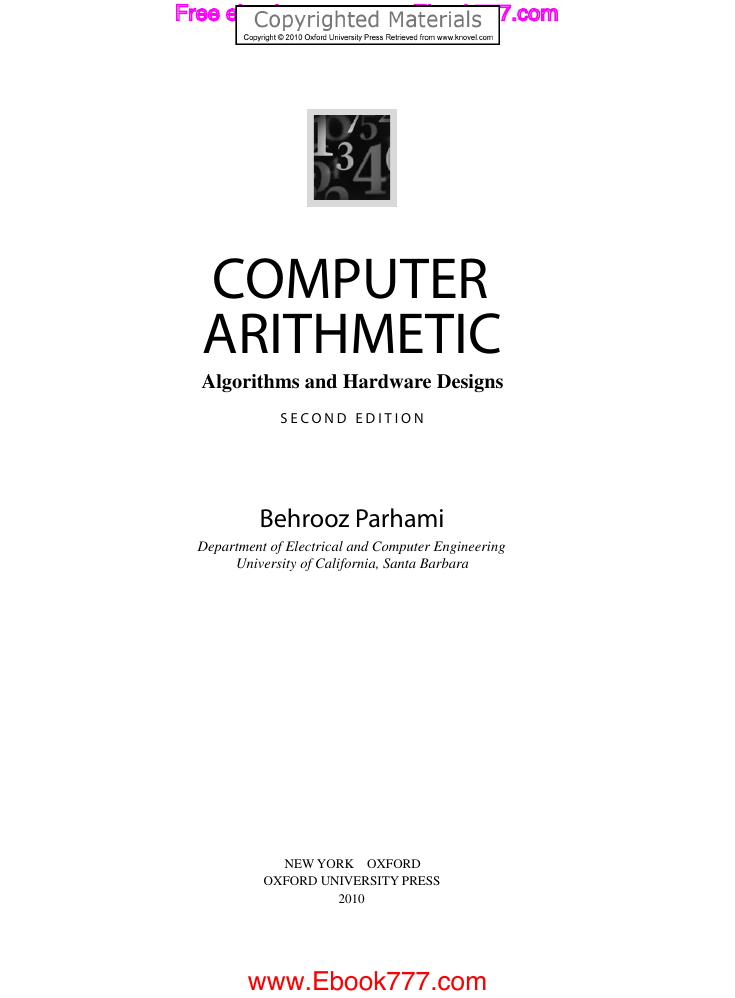
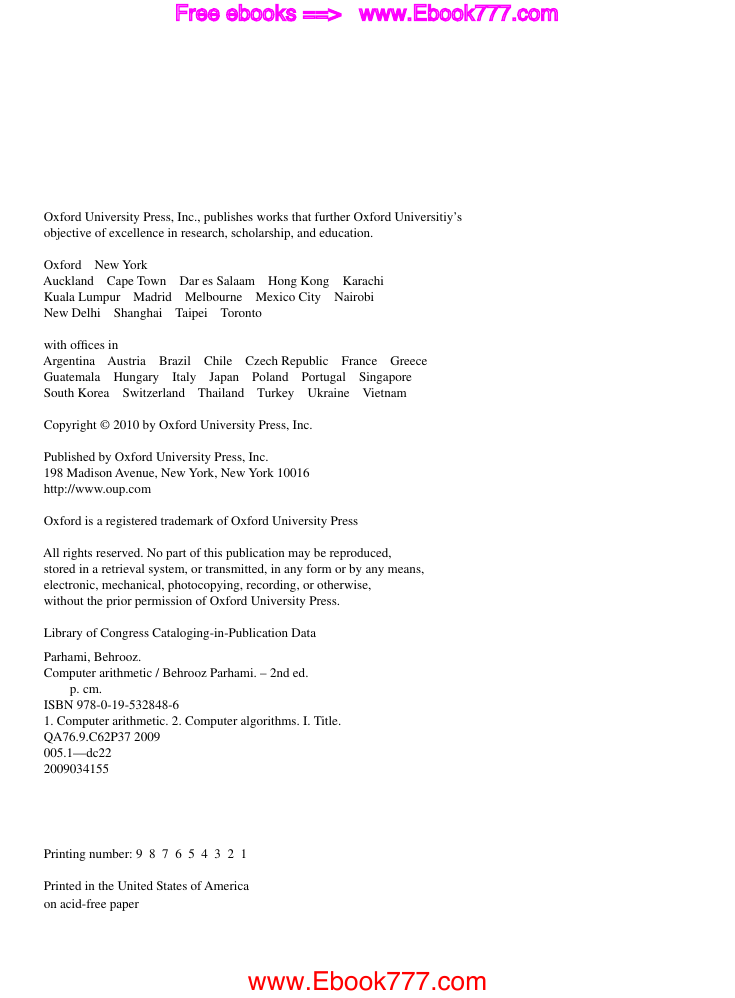


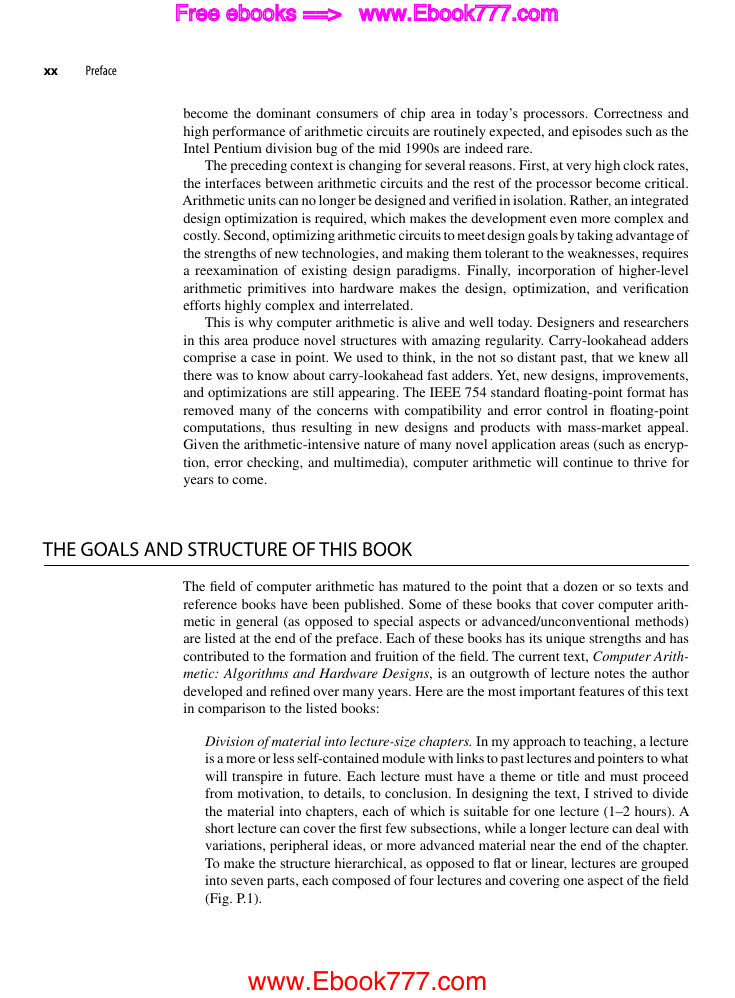
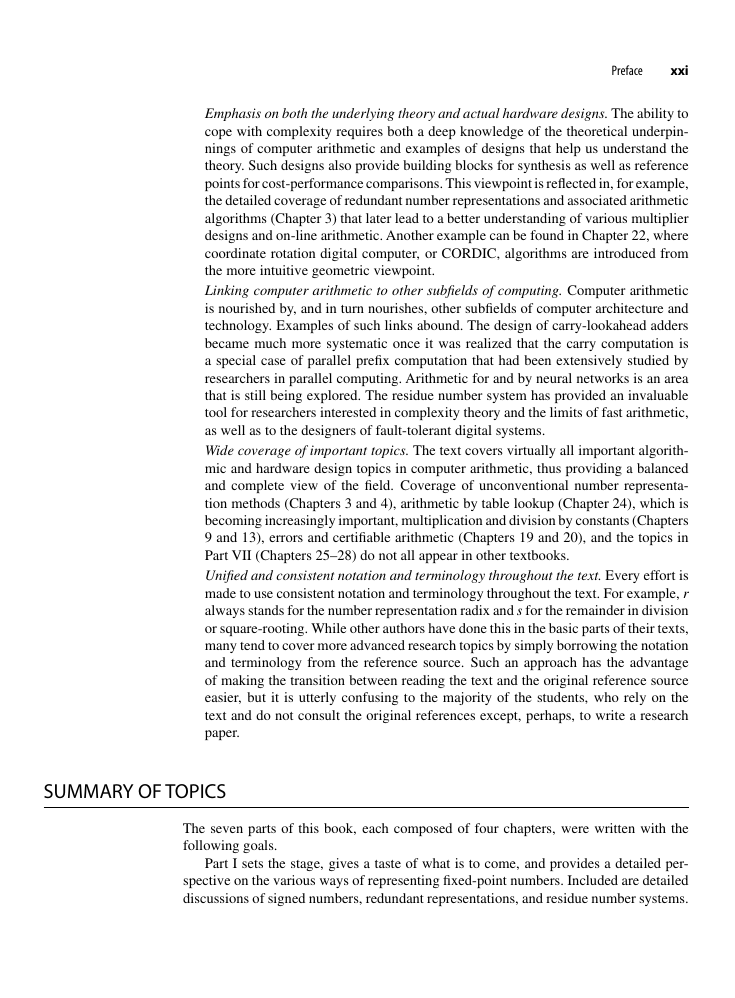

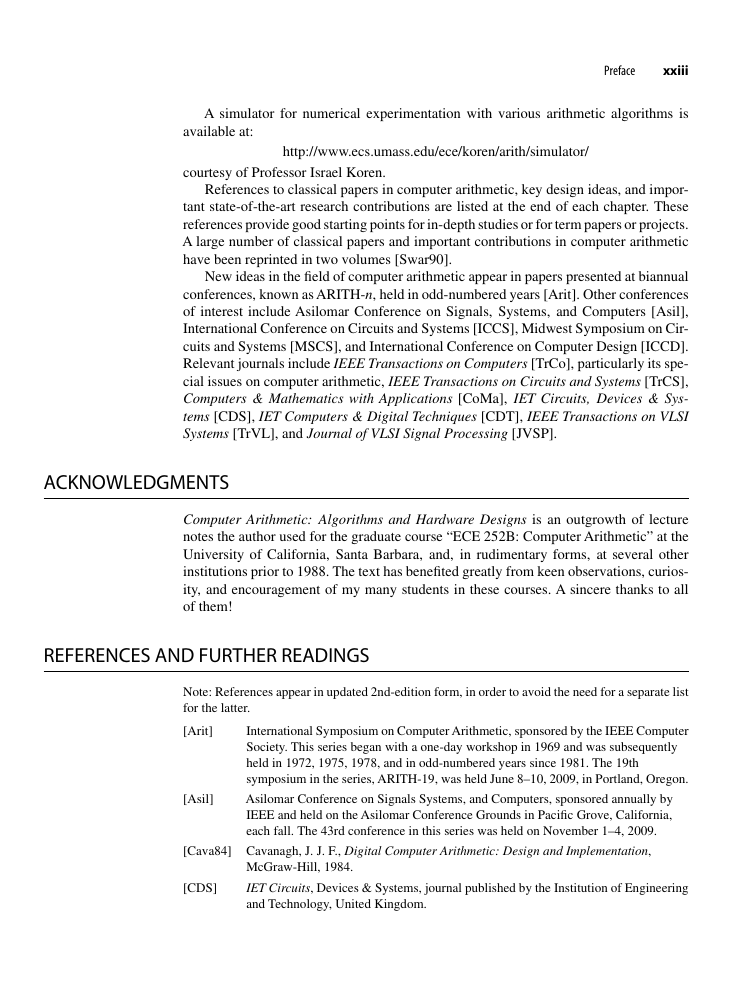








 2023年江西萍乡中考道德与法治真题及答案.doc
2023年江西萍乡中考道德与法治真题及答案.doc 2012年重庆南川中考生物真题及答案.doc
2012年重庆南川中考生物真题及答案.doc 2013年江西师范大学地理学综合及文艺理论基础考研真题.doc
2013年江西师范大学地理学综合及文艺理论基础考研真题.doc 2020年四川甘孜小升初语文真题及答案I卷.doc
2020年四川甘孜小升初语文真题及答案I卷.doc 2020年注册岩土工程师专业基础考试真题及答案.doc
2020年注册岩土工程师专业基础考试真题及答案.doc 2023-2024学年福建省厦门市九年级上学期数学月考试题及答案.doc
2023-2024学年福建省厦门市九年级上学期数学月考试题及答案.doc 2021-2022学年辽宁省沈阳市大东区九年级上学期语文期末试题及答案.doc
2021-2022学年辽宁省沈阳市大东区九年级上学期语文期末试题及答案.doc 2022-2023学年北京东城区初三第一学期物理期末试卷及答案.doc
2022-2023学年北京东城区初三第一学期物理期末试卷及答案.doc 2018上半年江西教师资格初中地理学科知识与教学能力真题及答案.doc
2018上半年江西教师资格初中地理学科知识与教学能力真题及答案.doc 2012年河北国家公务员申论考试真题及答案-省级.doc
2012年河北国家公务员申论考试真题及答案-省级.doc 2020-2021学年江苏省扬州市江都区邵樊片九年级上学期数学第一次质量检测试题及答案.doc
2020-2021学年江苏省扬州市江都区邵樊片九年级上学期数学第一次质量检测试题及答案.doc 2022下半年黑龙江教师资格证中学综合素质真题及答案.doc
2022下半年黑龙江教师资格证中学综合素质真题及答案.doc